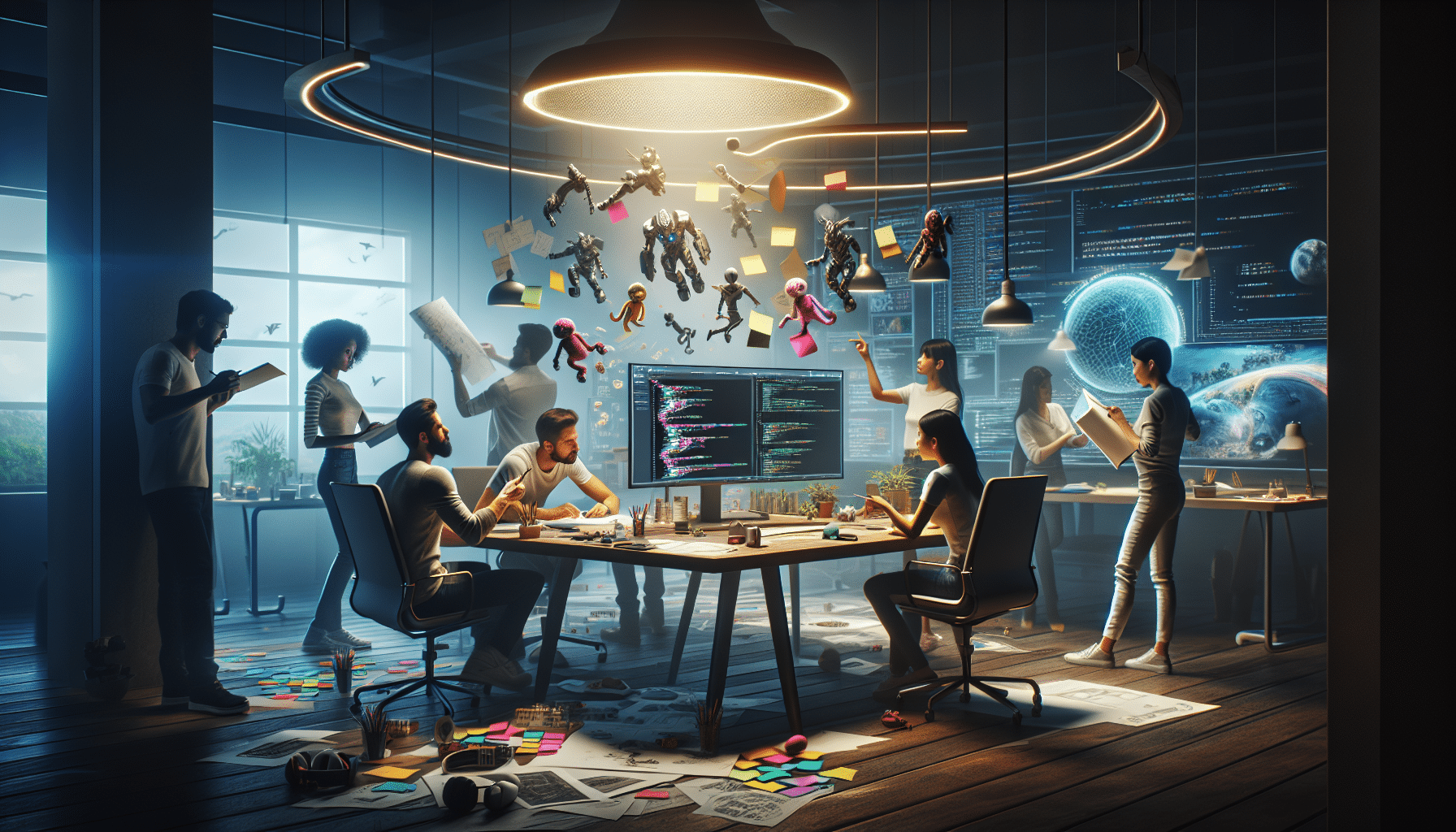Adverts
Game development is a fascinating world that combines creativity, technology, and innovation. From the initial conception of an idea to its final implementation in code, each step of the process requires dedication and specific skills. In this space, we will explore the path from brainstorming to technological reality, revealing how imagination transforms into interactive and engaging experiences. The journey begins with idea generation, where inspiration can come from many sources, such as movies, books, or even everyday life. This phase is crucial, as it is where the essence of the game is defined: storyline, characters, and mechanics. Next, the process delves deeper into prototyping and testing, allowing abstract concepts to take shape and become tangible. Validating ideas through feedback and iteration is essential to creating a final product that resonates with the audience. Finally, the transition to technical development brings its own challenges, such as choosing the right tools and programming interactions. This article will examine each of these steps in detail, highlighting the skills required and best practices that can be adopted. The intersection of art and technology will be analyzed, providing a comprehensive view of how ideas become reality in one of the most dynamic sectors of contemporary entertainment. 🎮✨
Adverts
From brainstorming to design: the early stages of game development
Adverts
Game development is a journey that begins with a moment of pure creativity: the brainstorm. In this phase, developers, designers, and other stakeholders come together to generate ideas and concepts that will serve as the backbone of the project. Brainstorming is an essential practice because it allows for the exploration of possibilities and the fostering of creativity, resulting in a range of ideas that can be refined later.
During brainstorming, it is common to use several techniques to stimulate the team's creativity, such as:
- Mind maps: A visual way of organizing ideas that can help identify connections between different concepts.
- Brainwriting: Instead of speaking, participants write their ideas on paper, which they then exchange with each other to generate new inspiration.
- Role-playing: Putting yourself in the end user’s shoes can help you better understand the needs and wants of your target audience.
After the brainstorming session, the ideas generated are evaluated based on their technical feasibility, commercial appeal, and originality. It is crucial for the team to identify which concepts can be transformed into an engaging gaming experience. This usually results in the selection of one or more concepts to proceed to the next phase: design.
Concept development: from paper to screen
After selecting the most promising ideas, the team begins developing the concept. This step involves creating a narrative, defining characters, game mechanics, and building the world in which the story will unfold. The goal is to create a Game Design Document (GDD), which will serve as a detailed guide for the team throughout the development process.
Fundamental elements of the Game Design Document (GDD)
The GDD is a living document that evolves throughout development, but initially it must contain the following fundamental elements:
- Overview: A brief description of the game, including genre, target audience, and platform.
- History and Narrative: Plot summary, character development, and possible narrative arcs.
- Game Mechanics: Details about how the player interacts with the game, including controls, rules, and objectives.
- Visual and Sound Style: Artistic and sound references that will help define the game's aesthetic.
The GDD is not just a collection of ideas, but a strategic roadmap that guides the development team’s decisions. It should be clear and accessible, allowing all team members to understand the game’s vision and their individual responsibilities.
Prototyping: testing ideas and mechanics
The next phase of game development is prototyping, which allows developers to test their ideas in a functional format. Prototyping is a crucial part of the process, as it provides a hands-on look at how game mechanics work in practice and how players interact with the content.
There are different approaches to prototyping, including:
- Paper prototyping: Uses drawings, maps and sheets to simulate gameplay before any coding.
- Digital prototyping: Creating an initial version of the game using game development tools such as Unity or Unreal Engine.
- Rapid prototyping: Focus on quickly implementing game mechanics to test and iterate.
Regardless of the method you choose, the goal of prototyping is to get feedback as early as possible. The team should be willing to iterate and tweak the game based on feedback from testers, allowing the final product to be more polished and engaging.
Technical development: from design to code
With the GDD and prototypes in place, the team moves on to the technical development phase, where ideas begin to become reality through coding. This stage involves multiple disciplines, including programming, graphic design, sound design, and quality assurance testing.
Main areas of focus in technical development
During technical development, the team must pay attention to several critical areas, which include:
- Schedule: Developers create the logic of the game, implementing mechanics, systems, and interactions. The choice of programming language and game engine can have a big impact on efficiency and the ability to make changes in the future.
- Graphic Design: Artists create visuals that bring the game to life, including characters, environments, and interfaces. It is essential that the visual style aligns with the game's narrative and mechanics.
- Sound Design: Audio plays a vital role in creating the atmosphere of a game. This includes background music, sound effects, and character voices.
Additionally, documentation and ongoing communication between team members are vital to ensure everyone is on the same page and the project is progressing as planned. Project management tools like Jira or Trello are often used to track progress and pending tasks.
Testing and Iteration: Refining the Player Experience
Once the game mechanics are implemented, the team must enter a rigorous testing phase. Testing is essential to ensure that the game works as expected and that players have an enjoyable, flawless experience. This phase can include different types of testing, such as:
- Gameplay Tests: They evaluate game mechanics, difficulty, and fun. It involves observing real players as they play to identify problems and opportunities for improvement.
- Bug testing: They focus on finding and fixing technical bugs that can affect performance and gameplay.
- Usability testing: They evaluate the user interface and overall player experience, ensuring the game is intuitive and accessible.
Feedback from testing should be taken into account when making any necessary iterations on the game. This could involve tweaking mechanics, refining the narrative, or improving the graphics. Flexibility and willingness to change are key at this stage, as this is often where the best ideas emerge.
Preparing for launch: marketing and distribution
As the game nears completion, the team must begin to focus on preparing for launch. This involves a number of activities related to the marketing and distribution of the game, which are essential to ensuring that it reaches its target audience effectively.
Marketing Strategies for Games
A successful marketing strategy may include:
- Creating trailers and teasers: Attractive visual content that generates anticipation around the game.
- Social Media Marketing: Using platforms like Twitter, Instagram and TikTok to interact with the community and create a buzz around the launch.
- Participation in events: Showcasing the game at game shows, conventions, and digital events to reach a wider audience and get direct feedback.
The game can be distributed through various platforms, such as Steam, Epic Games Store, consoles or even physical stores. The choice of distribution platform must be strategic, taking into account the target audience and the characteristics of the game.
Post-launch support: maintenance and updates
Once a game is released, the team’s work isn’t done. Post-launch support is crucial to ensuring player satisfaction and the longevity of the product. This can include fixing bugs, releasing updates, and adding new content.
The team should monitor player reviews and feedback to identify areas that need improvement. Maintaining open communication with the community is vital to building a loyal and engaged fan base. Regular updates can keep players engaged and provide new experiences that keep the game relevant over time.
Final thoughts on game development
Game development is a complex, multifaceted process that combines creativity, technology, and collaboration. From the initial brainstorming to post-launch support, each step is critical to creating an engaging and successful experience for players. Developers must remain agile and willing to adapt to change, always looking for new ways to improve their final product.
With technology and player expectations constantly evolving, the future of game development promises to be as exciting as it is challenging. The combination of innovation, skill and passion will be the key to success in an increasingly competitive market.

Conclusion
In short, game development is a fascinating process that transitions from creativity to technological reality, connecting ideas and innovations. Initially, brainstorming serves as the foundation where imagination flourishes, allowing unique concepts to come to life. As ideas solidify, the transition to design and programming occurs, transforming creative visions into interactive experiences. During this journey, collaboration between different disciplines — such as art, storytelling, and programming — is essential, as each element contributes to building a cohesive and engaging game.
Additionally, the use of emerging tools and technologies has expanded creative possibilities, allowing developers to explore new narratives and gameplay mechanics. Therefore, as the gaming industry continues to evolve, it is crucial that creators remain open to new approaches and collaborations, further enriching the gaming universe.
Ultimately, the ability to transform ideas into interactive experiences not only enriches entertainment, but also offers a new form of artistic expression. In this way, the journey from brainstorming to coding is more than a process; it is a celebration of human creativity and technological innovation. 🕹️✨




